There are so many reasons to love houseplants. From purportedly removing pollutants and reducing stress to increasing focus and creativity, they bring some of the outdoors inside and are, almost literally, a breath of fresh air.
But given that they were designed to live outside in the ground and in accordance with Mother Nature, if we decide to foster them inside, we have to take care to treat them well. And one of the ways in which we mess up the most is with watering.
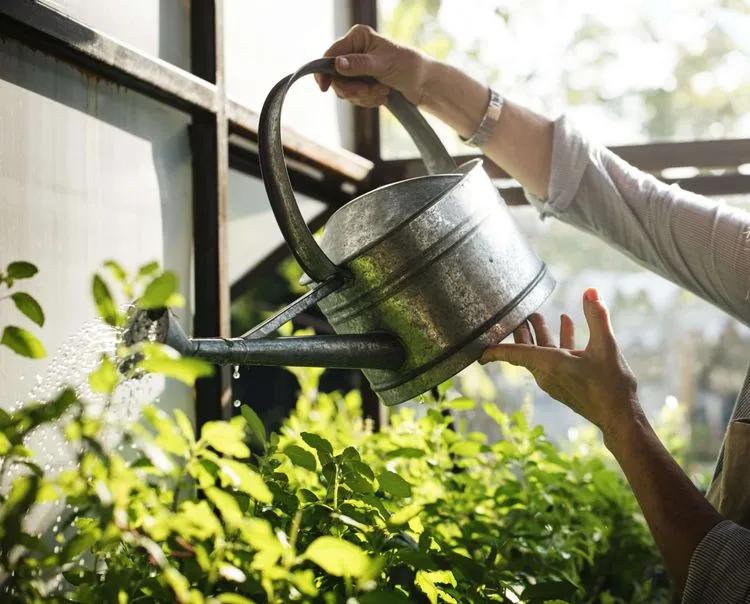
Watering problems are the leading cause of poor health for houseplants; here’s how to give them what they need. Water provides structural support, cools your plant down, and moves minerals to all the right places.
Plant cells are like water balloons. When they are filled, they become stiff and your plant stands upright. When there is a lack of water, the cells deflate and the plant looks wilted — a clear sign your plant needs more water. Plants produce cellulose that help keep its shape, but it’s water pressure (water flowing through your plant) that helps plants gain and retain their shape better than cellulose alone.
When you water your plant, an invisible process called transpiration takes place where the sun evaporates water from the leaves through stomatal pores, causing water loss in the leaf. That’s great, because water will go where it’s needed most. Ideally, the water is pulled up from the roots, but if roots are dry, water is taken from the leaves themselves, which can result in a deflated plant — an indication your plant is thirsty.
Watering Soil
Keep in mind your soil is like a sponge. Most houseplants like a porous soil, allowing room for water and air pockets. If your soil is moist to begin with, hold off on watering for now. If you notice water pours out through the drainage holes immediately, your soil is actually bone dry and the soil is repelling water, rather than soaking it in. Avoid pouring water onto bone dry soil. Water will only move through and around the edges of your planter and will not be absorbed by the roots. Your plant should absorb water slowly through its roots so, before you water again, you’ll want to check how dry the soil is. Use your fingers and feel if the soil is wet at least 2 inches below the surface. If so, you can add water. If your soil is wet at the surface, you can hold off.
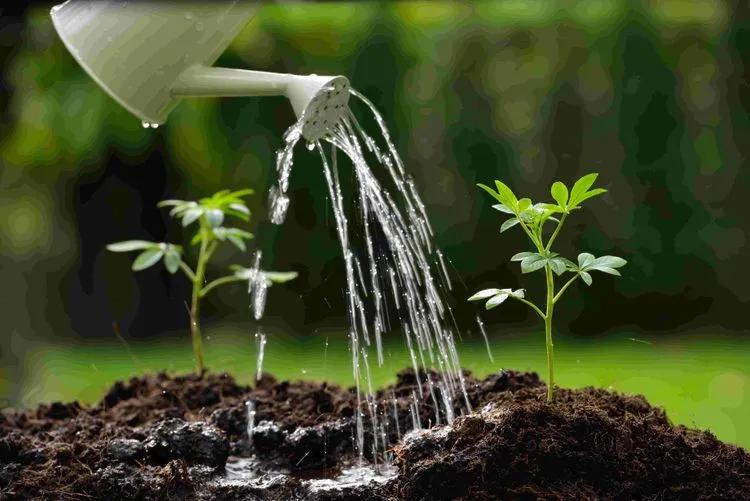
Different Watering Needs
Each plant has a different watering need. And not just from species to species, but also depending on a plant’s pot and potting medium, its location in the home, the weather, the season, et cetera. But once you know how to read a plant and its soil, which isn’t that hard, you can master the art of watering.
Some plants are guzzlers, others don’t need water for weeks, many are somewhere in-between – so it’s good to do a little research and see generally where each specific species falls on the water spectrum.
Further variables include:
- Potting medium (can add to moisture or dryness)
- Light exposure
- Temperature
- Humidity
- Dormant phase versus growth phase (many plants grow more during spring and summer, and want more water then)
- Hanging versus sitting (hanging plants dry out more quickly)

How to Check if the Watering Needed?
With most plants, you should water when the soil feels dry to the touch. You can gently stick your finger (up to the knuckle or so) in the soil to see how dry it is. For water lovers, water when the surface is dry; for succulents and drier plants, water when most of the soil feels dry.
No fancy gardening equipment is required to figure out whether or not you should water your houseplants, vegetable garden, or outdoor planters. Put your finger about two inches into the soil. If the soil feels moist, don't water it; if it feels dry or on the verge of being dry, then water it. Roots are the lifeline of the plant, deep in the soil and growing. But if they get waterlogged and rot, they can't absorb water, nutrients, or oxygen-all things a plant needs to grow.
Also, you can lift a potted plant (or carefully tilt or nudge the pot if it’s a big one) to gauge how wet the soil is. If you get a sense for its weight right after you water, you will have a base weight to compare it to as it dries out.
If the soil is dry and the leaves are wilting, the plant is likely thirsty. But wilting (and dropping and/or yellowing) leaves can also mean too much water.
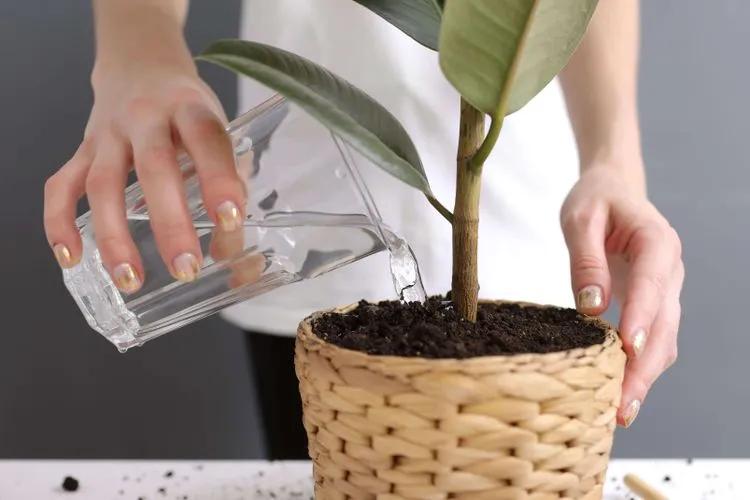
If you're stingy with the H2O, that's also bad news. Thirsty plants get stressed and are more prone to pests and disease. Their growth will also slow down.
Most plants (but not all, because plants are wily things) will want more water in spring and summer, and less during their dormant period in fall and winter – you can tell their growth and dormant phases by when they are growing the most.
Because the variables that affect a plant’s thirst are ever changing, it’s best not to stick to a fixed schedule.
Since soggy leaves can invite disease and fungus, the best time to water is in the morning, giving the plant the daytime to dry out. For plants by windows that are accustomed to a lot of light, be careful of overwatering on cloudy days since their foliage will not dry out at the usual rate.
You can easily shortchange your plants by watering at the wrong time of day. The most optimal time is early morning evening when temperatures are at their coolest (early evening is okay, too). If you water plants at a time of day when the sun was hot and blazing, the water on leaves will evaporate too quickly, leaving plants parched until the next watering.
Types of Water to Use
The kind of water to use is tepid. Just like you probably don’t like an ice-cold shower, your plants don’t either. Frigid water straight from the faucet can shock the roots, especially for tropical plants who spend their time dreaming of the sultry rainforest. You can fill the watering can when you’re done watering; when the time comes to water again, the water is perfectly room temperature – and if it’s tap water, it has a chance to dechlorinate.
Rainwater is probably a plant’s favorite, if you don’t live in a place with too much pollution, that is. Well water is usually good too, if it’s not too alkaline for acid-loving houseplants. Tap water can be great, but the salt in softened water can become problematic – and some plants don’t like chlorinated water.
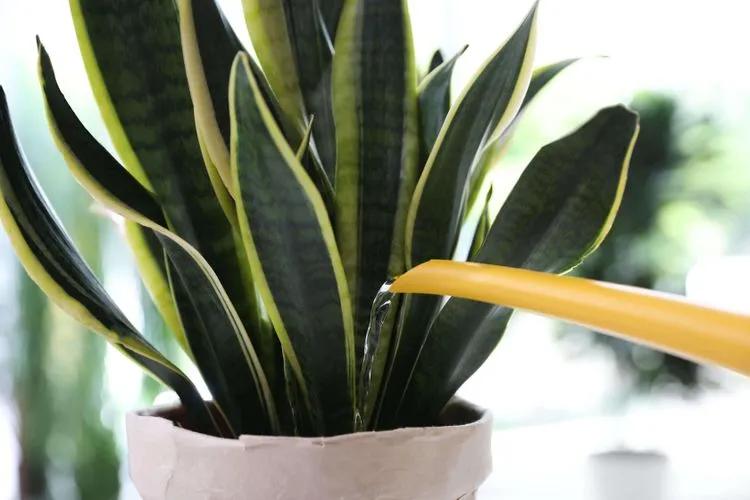
Finding the right water can take some trial and error. Wondering if tap water is OK for your plants? The short answer is, it depends. Most tap water should be fine for your houseplants unless it is softened because it has salts that can build up in the soil over time and eventually cause problems. Chlorinated water is also safe for most houseplants, but if you have a filtration system, that's even better for your plants. Another option is collecting rainwater to use.
No matter what type of water you choose, room-temperature liquid is better than either warm or cold. Either extreme can damage your houseplants' leaves, so it's best to refill your watering can right away after each session and let it sit until next time. That way, it has plenty of time to even out to the right temperature.
How to Water?
Water deeply - when you do it, do it thoroughly so water reaches the roots. To water deeply, place a hose or watering can at the base of the plant, avoiding the leaves, which don't need water and could become diseased if wet overnight. Keep the water going until it's steeped into the soil. Distribute water evenly around the entire plant rather than pointing the nozzle towards a single area.
A watering can with a long spout gives the best control for directing water all around the soil, while avoiding wetting the leaves – again, for many plants, wet leaves invite fungus.
Watering from below is best. Although watering from above is still the usual way people water their plants, watering from underneath is more homogeneous, less prone to overwatering and there is no concern of draining nutrients out. Plus, you can be sure that the water does actually get to the roots.
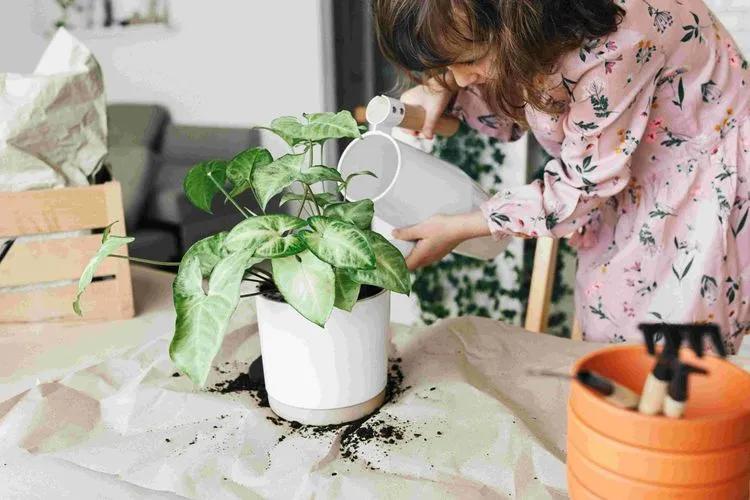
3 Techniques to Water Your Plant From Below
Use a saucer. Place a saucer underneath the pot and fill the saucer with fresh water when it's time to water. Let it soak during several hours. Empty the saucer and let the remaining water drip out. This technique is widely used by garden centers and plant nurseries to maintain humidity and keep nutrients.
Soak your plants in a tray, in a large container, in the sink or in the bathtub. Fill the bottom of it with a few centimeters of fresh water. Place you plant pots in and let them absorb water for a couple of hours. Advantage: you can water several plants at the same time. Let them dry before placing them back.
Self-watering pots. Self-watering pots are incredibly useful and time-saving. No more over-watering or under-watering, the plant does it all for itself. You just need to refill the water reservoir before it's empty, which is approximately every other month (but varies case by case)
The only problem with bottom-watered plants is that it doesn’t remove excess salts from the soil like top watering does. Easy solution: Top water your bottom-watered plants once a month or so. Since a houseplant doesn’t have the benefit of worms and other creatures to aerate the soil, its humans need to poke some holes in the soil from time to time – allowing the water get to where it needs to go. This helps “break up dry pockets of soil, ensure even moisture distribution, and get airflow to the roots”.
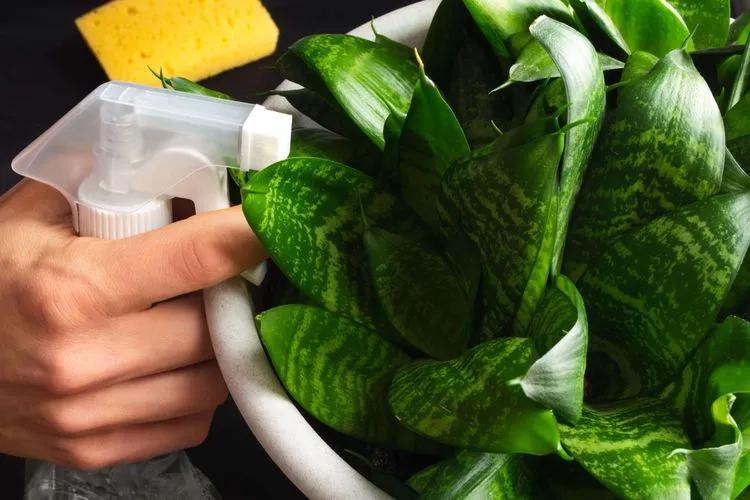
Proper Amount of Water
Some plants naturally may want less water, like cacti, succulents, and plants with thick leaves. Most of the rest like to drink. And remember, they usually want drinks, not bitty little sips. Add enough water so that water comes out of the drain hole – you want all the roots to get wet, and enough water to flush out salts.
Plant size will also determine how much water your plant needs. In smaller pots with less soil, the soil will dry out faster than in larger pots with lots of soil. If you have two of the same plant and one is larger than other, one will need water more often than the other.
For large plants, pour water and let it soak in. Repeat until soil is saturated. Let it dry until watering again. For smaller plants do a semi-soak by placing the potted plant in a tray and pouring water over the soil until the tray has about ¼ of an inch of water. Let the plant sit for 8 hours, then drain the water.
If the potting medium is really dry, it has a harder time absorbing the water – so if water runs out the bottom surprisingly quickly, it is probably passing right through. In this case, give the plant a long, slow drink to allow the soil to absorb it.
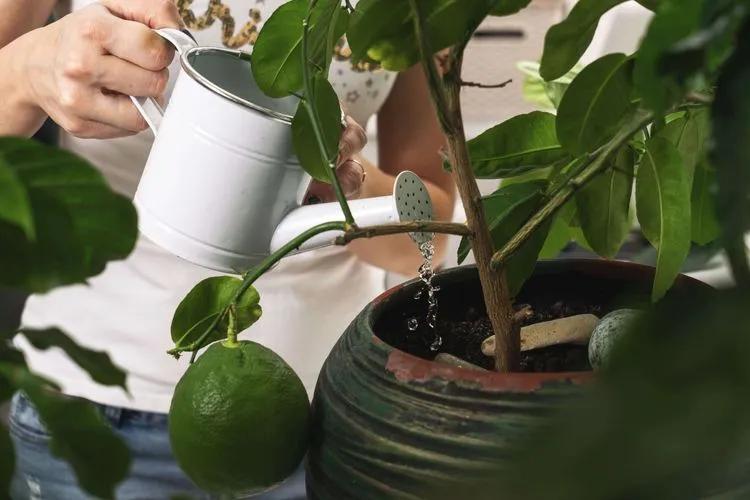
For really dry plants, you may notice that the soil has dried up enough to create a gap between the edge and the pot – in this case, gently nudge the soil back into place so that the water doesn’t have an escape route straight down the side.
Many plants root systems have a bit of a Goldilocks syndrome – they want not too little, not too much, but just the right amount. It’s not that exact, but one thing is certain: Most do not appreciate being forced to sit in their water for too long. Not only do they begin to soak the salt back up, but staying too wet can lead to rotting roots.
For a pot that sits inside of a decorative pot without a drain hole, make sure that the outer pot is not filled with water after watering. So check after 30 minutes and dump out any water from the outer pot.
If your pot sits on a saucer, also check back after 30 minutes and dump any lingering water out of the saucer. This give the plant enough time to get a little extra watering from the bottom, but not enough to lead to over-wetness problems.
Over Watering
There's a reason pots have drainage holes—too much water will literally drown your plants. That's because roots do need oxygen or they will rot and die. Even with good drainage, keeping the soil constantly wet can make it hard for air to reach the roots. There are a few ways to tell if you are overwatering your plants before it's too late to save them.
No new growth and yellowing leaves that are dropping off can be signs of overwatering. You may also notice wilting, which can be confusing because that is also a sign of too little water. The trick is to check the soil when you notice these problems: If it feels wet, you probably should go easier on the water. If the soil is dry, you may need to give your plant more water. If a drink doesn't improve things, you may need to adjust the temperatures or light levels your plant gets.
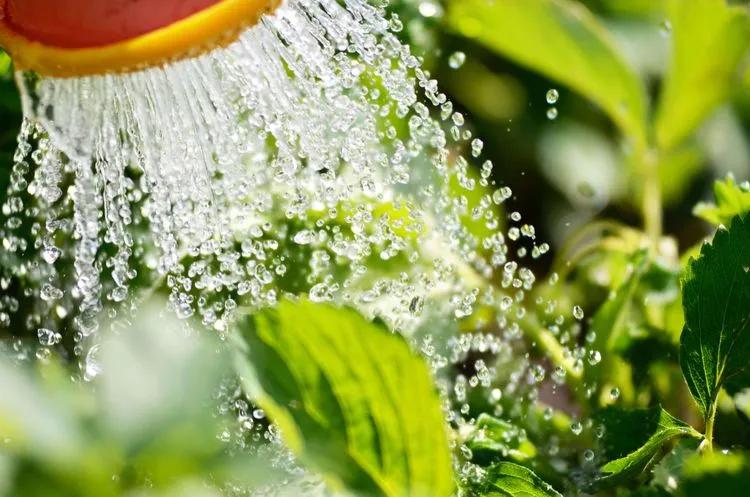
You can also use your nose to figure out if you've got an overwatering problem. Lots of moisture encourages fungi and bacteria to grow in the soil, which can cause unpleasant odors, especially when roots are rotting. And if you spot any fungus gnats flitting around your plant whenever you water, you've likely been too heavy-handed with the watering can.
If you think you've been overwatering, it doesn't necessarily mean your plant is doomed. Just let the soil dry out a bit before watering again. Then start following the watering techniques we describe above. If that doesn't help your plant bounce back, you can also try repotting it with fresh soil after trimming away any dead or mushy roots.
General Tips
Knowing how to water your houseplants definitely requires some experience. The more you do it, the better you'll get at caring for your indoor garden. Try starting with a few varieties that are tough to kill. Then, once you've mastered the basics and feel more confident in your watering skills, you can try taking on a few plants that are more challenging but totally worth the effort.
When it comes to watering in outdoor, there are no hard or fast rules. It's a judgment call that depends on the type of plant, the soil, the weather, the time of year and many other variables. Fortunately, it's easy to figure out what to do — even for a teenager on a hot summer day. You just need to check the soil.
Watering is of no value if the water runs down the outside of the root ball, leaving the roots at the core of the plant dry. This can happen if you water too quickly or apply too much water at once. Slower watering is usually more effective. The key is to ensure that water gets to the root zone — whether you are tending seedlings, watering houseplants, watering a row of tomatoes or soaking thirsty shrubs and trees.
You can't use the "lift test" in your garden or landscape, but you can use a soil moisture sensor to see if it's time to water. For a thorough investigation, push a spade into the soil near your plant and pull it back to see how the soil looks. If it feels moist to a depth of 6 to 12 inches, you're in good shape. If it's bone dry, water!
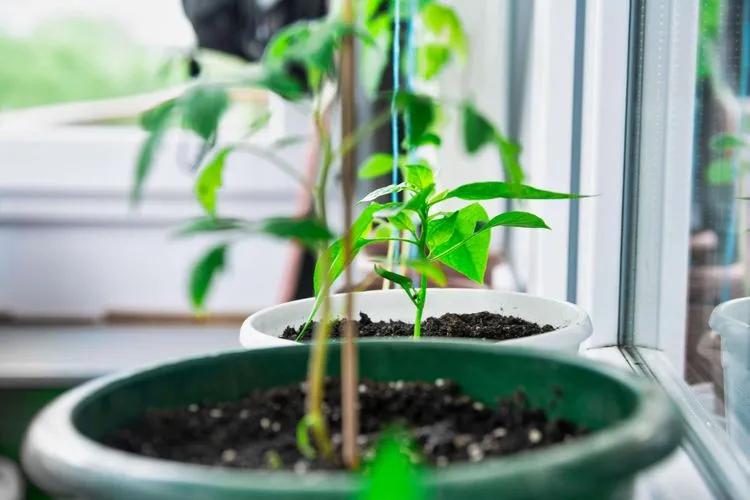
Six Tips For Watering Your Garden
- Focus on the root zone. Remember that it's the roots that need access to water, not the leaves. Wetting the foliage is a waste of water and can promote the spread of disease.
- Water only when needed. Automatic watering timers are especially useful; just make sure to watch the weather, and reduce frequency when rainfall is abundant. Too much moisture can be just as damaging to plants as too little.
- Water deeply and thoroughly. Lawns and annuals concentrate their roots in the top 6" of soil; for perennials, shrubs and trees, it's the top 12". In heavy soil, it may take hours for water to percolate down 6-12". Use your finger or a shovel to check the progress.
- Water in the morning. If you do get moisture on the leaves, this gives them time to dry out. It's much more difficult for plant diseases to get a foothold when the foliage is dry.
- Mulch everything. Mulch reduces surface runoff and slows evaporation from the soil.
- Use the right tool. For efficient watering at the root zone, use a soaker hose or an even more precise drip irrigation system instead of a sprinkler.
Check your plants and the soil daily to determine whether your plants need more water. While young seedlings may not use a lot of water, as your plants grow their water needs increase.
While most plants prefer soil that dries slightly before watering again, not all plants have the same watering needs. Always check the watering instructions for your specific plants.

FAQ
How Can I Adjust My Watering Routine for Different Seasons?
Most houseplants drink more in spring and summer when they’re actively growing, so water when the top inch of soil dries out. In fall and winter, growth slows, so let the soil dry a bit more between waterings. Always check the soil first
